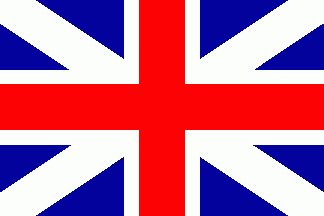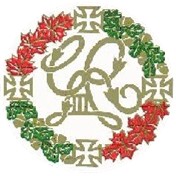Loyalist Iconography
Contents
- The Loyalist Flag: The First Royal Union Jack
- The Badge: The Loyalist Cypher
- The Loyalist Prayer, by Frank Rogers, UE
- The Loyalist Rose: Commemorating the 200th anniversary of the coming of the Loyalists
The Loyalist Flag
The First Royal Union Flag

The first Royal Union Flag sometimes called the Queen Anne Flag was created by command of James I of England (formerly James VI of Scotland) and it symbolized the union of those two countries. It is composed of the Cross of St. George (a red cross on a white background) and the Cross of St. Andrew (a diagonal white cross on a blue background).
By 1707, it was known as the Union Jack and accepted as the flag of the British Empire. It was the flag of Canada from 1759 to 1801 and the flag the Loyalists carried on their migration.
Source: Branch President's Manual, UELAC; Flag image provided by Bill Smy.
The Badge
The Loyalist Cypher

The badge of the Assocition consists of a wreath made up of Red Maple Leaves and Green Oak Leaves and Acorns. Maple Leaves occupy the upper left and lower right quarters of the circle; Oak makes up the remainder and each quarter is separated by a cross formy (i.e. a cross made up of four triangular shapes equal in size).GIIICipher
The Maple Leaves are of obvious relevance as the Association is 'of Canada'. On the other hand, the Oak Leaves and Acorns are a long held symbol of loyalty and fidelity to the Monarchy. In the British traditions, this has been particularly so since Charles the II was hidden in the Oak Tree after the Battle of Worcester in 1651. As a consequence, he chose an Oak Tree as the symbol for his Coronation Medal following the Restoration, and ever since, the oak had this particular symbolism of fidelity for loyalists.
The cross formy placed at each point where the Maple and Oak come together in the Badge is inspired by the form of cross which has long been used by the Association. In the centre is the Cypher G III R signifying Georgius Tertius Rex, the sovereign to whom the Loyalists gave their devotion and their service in such a pre-eminent manner. This Cypher is similar to the one actually used by George III during his lifetime.
Members should try to understand the symbolism and do what they can to honour their Loyalist ancestors
Source: Branch President's Manual, UELAC
Loyalist Prayer
By Frank Rogers, UE, Kawartha Branch, 1998

The Loyalist Rose
Commemorating the 200th Anniversary of the coming of the Loyalists
This antique rose, identified as "Maiden's Blush" of the Rosa Alba family, is illustrated in many Renaissance paintings.
It was taken to England from Damascus during the Crusades. In 1773, John Cameron of Clunes and Mary Cameron of Glen Nevis brought the rose with them when they emigrated to Sir William Johnson's estates in the Mohawk Valley of New York.
In 1776, John Cameron joined the King's Royal Regiment of New York. After the Revolution, the family carried the rose with them on their 230-mile trek over the Appalachians to the Cornwall area. It grows today in the Ottawa Valley in the gardens of the descendants of John and Mary Cameron.
Two hundred years later in 1976, Ethel MacLeod, a descendant, registered "The Loyalist Rose" with the International Registration Authority for Roses. She donated it to the United Empire Loyalsits' Association of Canada to mark the Bi-centennial for the American Revolution and the coming of the Loyalsits to Canada.
It is a cupped very double fragrent pale pink rose fading to white, bushy, densely branched blooming well in June.
Source: Branch President's Manual, UELAC
→ See also: Loyalist Rose presented to The Central Experimental Farm in Ottawa

